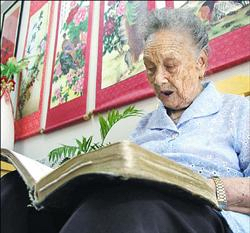Character amnesia yet again: game (almost) over
Last week, I witnessed a palpable, powerful, poignant demonstration of tíbǐwàngzì 提筆忘字 ("forgetting how to write sinographs; character amnesia"). This happened in a colloquium where, during the discussion period, someone mentioned the standard eight-volume Historical Atlas of China (1982-1988) edited by the renowned geographer Tan Qixiang (1911-1992). A member of the gathering requested that the name be written on the whiteboard in sinographs. A colleague — a tenured professor of medieval Chinese history — popped up and said they could write the name in characters.
Already a little bit wobbly on the semantophore / radical on the left side of the first character (the surname), with a little bit of kibitzing from colleagues, the volunteer managed to produce the requisite semantophore after several false starts and erasures. After that great achievement (producing the semantophore amid much embarrassment), they turned to the phonophore on the right side but were getting nowhere fast, even with suggestions from colleagues who were looking on.
Finally, someone looked up the name on their phone and presto digito*, the correct writing emerged: 譚其驤 / 谭其骧 (the group — scholars all — collectively preferred the traditional form over the simplified one).
—–
[*VHM: I remember hearing this expression when I was young, but it barely exists on the internet, and I can't find it in dictionaries either.]
Read the rest of this entry »
Why is Facebook's Chinese translation still so terrible?
[This is a guest post by Jenny Chu]
It came up today when I was reading this somewhat viral post on Facebook.
Dumpling ingredients and character amnesia, part 2
This post follows in the path of its classic predecessor, "Dumpling ingredients and character amnesia" (10/18/14), must see. Here we begin with this provisions list:
Read the rest of this entry »
On how (not) to learn Latin via French
And how (not) to learn Literary Sinitic / Classical Chinese via Mandarin
A "Little Horatian Satire" by E. Bruce Brooks
A section of Classical Chinese Primer by E. Bruce Brooks and A. Taeko Brooks
The dominance of modern-Chinese based curricula may be inevitable in the present political climate, but it is objectively strange all the same. In practice, it prevents the classical language from being acquired by anyone who does not have a use for the usual prerequisite: two or three years of the modern language. The comparative philosophers and historians, the students of ancient technology, and those moved by mere intellectual and literary curiosity, are thus excluded at the outset. Is it healthy for the field, to have nobody to talk to in these neighboring disciplines? And what of the future Chinese classicists themselves, whose linguistic antennae are being tuned, by arduous toil, to a point 2,000 years later than the texts of primary interest to them?
What if the Mediterranean Classicists did as the Sinological Classicists do? An American college freshman with perfect SAT's and a burning desire to investigate the metrics of Horace walks into the Classics program advisor's office and announces her goal. She expects a welcome, and a fast-track Latin class. Instead, she gets the following:
Read the rest of this entry »
The birth of Spanish
New article by Johnson in The Economist (4/23/22):
On the origin of languages
It is tempting to think that they have clear beginnings. They don’t
First two paragraphs:
IN A CHURCH hewn out of a mountainside, just over a thousand years or so ago, a monk was struggling with a passage in Latin. He did what others like him have done, writing the tricky bits in his own language between the lines of text and at the edges. What makes these marginalia more than marginal is that they are considered the first words ever written in Spanish.
The “Emilian glosses” were written at the monastery of Suso, which was founded by St Aemilianus (Millán, in Spanish) in the La Rioja region of Spain. Known as la cuna del castellano, “the cradle of Castilian”, it is a UNESCO world heritage site and a great tourist draw. In 1977 Spain celebrated 1,000 years of the Spanish language there.
Read the rest of this entry »
Hokkien at UCLA, part 2
Referring to the first post in this series, "Hokkien at UCLA" (4/20/22), Chau Wu writes:
I totally agree with you about the Chinese prerequisite.
When I was younger (no, a lot younger) back in Taiwan, I had known a few grandmotherly Christian ladies who were illiterate in Sinitic script but perfectly at home in reading the Taiwanese Bible in Pe̍h-ōe-jī (POJ), i.e., Church Romanization (see below at * for further discussion). The following pictures appeared in the Taiwanese newspaper 自由時報 (Liberty Times) (Hokkien POJ Chū-iû-sî-pò; Hanyu Pinyin Zìyóu Shíbào) a few years ago about a Mrs. Lin (unrelated to any of the ladies I knew of) reading the Bible (Note the Bible shows signs of having been heavily used):
Read the rest of this entry »
New official night market sign with Taiwanese
The Shalu district of Taichung (Taizhong) is opening a new night market:
Read the rest of this entry »
The pragmatic and innovative Choe Sejin — 15th-16th c. Korean phonetician, translator, and interpreter
[This is a guest post by S. Robert Ramsey]

The Statue of King Sejong in Downtown Seoul.
The brilliance of good king Sejong (1397-1450) overshadows another great mind of Joseon Korea, a middle-class man named Choe Sejin (1465-1542).
Read the rest of this entry »
Wait until leader clears the lunar
Riding the trolley from West Philadelphia going to University City,
https://twitter.com/slurve/status/563688361316339713
Read the rest of this entry »
Hokkien at UCLA
Article in Taiwan News:
"UCLA students learn about Taiwanese Hokkien in MOE*-supported course:
Course examines Taiwan’s widely-spoken dialect ‘in different forms of cultural production’", By Stephanie Chiang (4/19/22)
*Ministry of Education
UCLA began offering its first Taiwanese Hokkien course in January 2020:
The description of the course entitled “Taiwanese Language and Culture” reads, “Taiyu, or Taiwanese (also known as Minnan, Hoklo, or Hokkien, depending on context or region), is the language that most Taiwanese people use in daily lives, including everyday interaction and communication, entertainment, social and cultural events, etc.” The four-unit course offered to upper-division students requires students to have taken at least a year of Chinese courses or a Chinese placement test showing equivalent knowledge.
I wish they didn't have the prerequisite mentioned in the last sentence and don't understand the reason for such a requirement.
Read the rest of this entry »
John Knox as a Romance author
For reasons not at all connected with this post, I was looking for scans of the 1558 (first) printing of John Knox's infamous screed THE FIRST BLAST OF THE TRUMPET against the monstruous regiment of Women. And one of the places that Google sent me to was a link on the website of the Somerset County (New Jersey) Library System , where the work is apparently classified as a Romance novel:
Read the rest of this entry »





